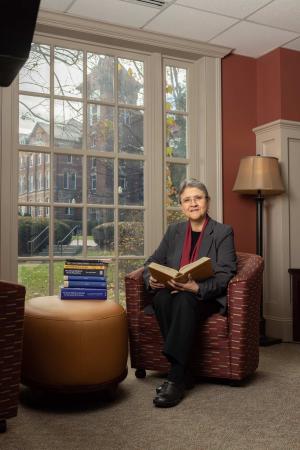The first program in women’s studies in the United States was approved at San Diego State University in 1970. Saint Anselm College also is celebrating the 50th anniversary of women at the college this year. It is nice to know that our college joined this major change of increasing the access of women to education.
How long have you been at Saint Anselm?
I joined the theology department in 2006, so 17 years. I begin counting my journey at Saint Anselm College on the day I first visited campus for my interview on December 8, 2005 [The Feast of the Immaculate Conception]. Part of my day included going to Mass at the Abbey Church. Seeing the students, faculty, and staff gather, I knew this would be a good place for me and my family.
Your research focuses on the intersection of gender, culture, ethnicity, and race in the interpretation of the Bible. What would people be surprised to know about this?

I think the major surprise is that people think these areas have been part of research for a long time, but these topics became part of scholars’ critical reflection mainly in the latter part of last century (since the 1970s). The reason is because of the limited access to education for minoritized communities. I say minoritized because, for example, although women are more than half of humanity, their access to higher education was limited. The first program in women’s studies in the United States was approved at San Diego State University in 1970. Saint Anselm College also is celebrating the 50th anniversary of women at the college this year. It is nice to know that our college joined this major change of increasing the access of women to education.
What do you want your students to leave your class with?
My hope is they will read the Bible in a different way. I help them understand the importance of putting texts in contexts (both ancient and contemporary). I try to equip them with the necessary tools to do a critical analysis of the text. The goal is that they learn to do informed readings and interpretations of the Bible, and of any text that comes their way.
What else are you working on?
I am currently the president-elect of the Academy of Catholic Hispanic Theologians of the United States (ACHTUS). This June, we will be gathering for the 35th annual colloquium. This year’s theme is “Synodality En Conjunto: The People of God, the Bible, and Theology.” The presentations for this colloquium will also be published as a volume, and will have the same title as the confer- ence. Additionally, I am working on The Oxford Handbook of Latinx and Latin American Biblical Interpretation. I am co-editor of this, together with Dr. Fernando Segovia (Professor of New Testament at Vanderbilt University). It is a major research project involving more than 45 authors from North America (the U.S. and Canada), Latin America, and the Caribbean.
When not on the Hilltop, where can we find you?
At home, doing research. I love what I do. My home is surrounded by woods, so it is very tranquil and inspiring. Despite my family’s complaints, I take over my dining table, which is full of books, and I just keep doing my research.
Ahida Pilarski
Professor, Theology
B.A., 1992, Facultad de Teología Pontificia y Civil de Lima (Perú), Theology
M.A., 1998, Catholic Theological Union, Theology (Old Testament) Th.M., 1999, Lutheran School of Theology at Chicago, Old and New Testaments
M.L.A., 2006, The University of Chicago, Liberal Arts
Ph.D., 2008, Lutheran School of Theology at Chicago, Hebrew Bible/ Old Testament
